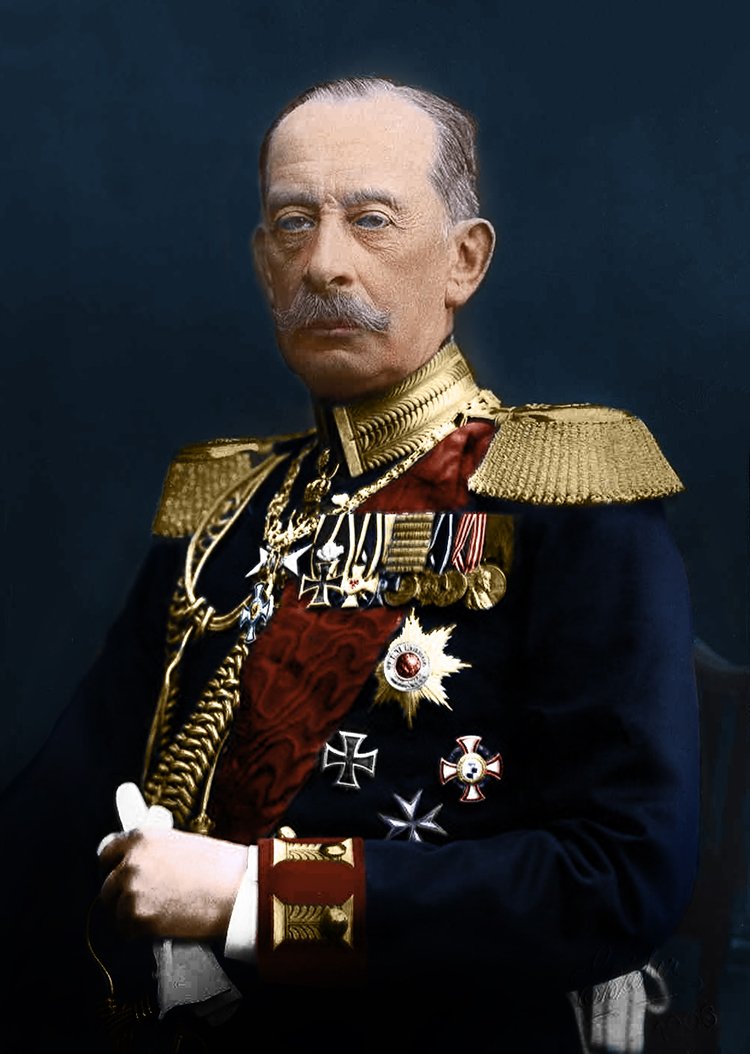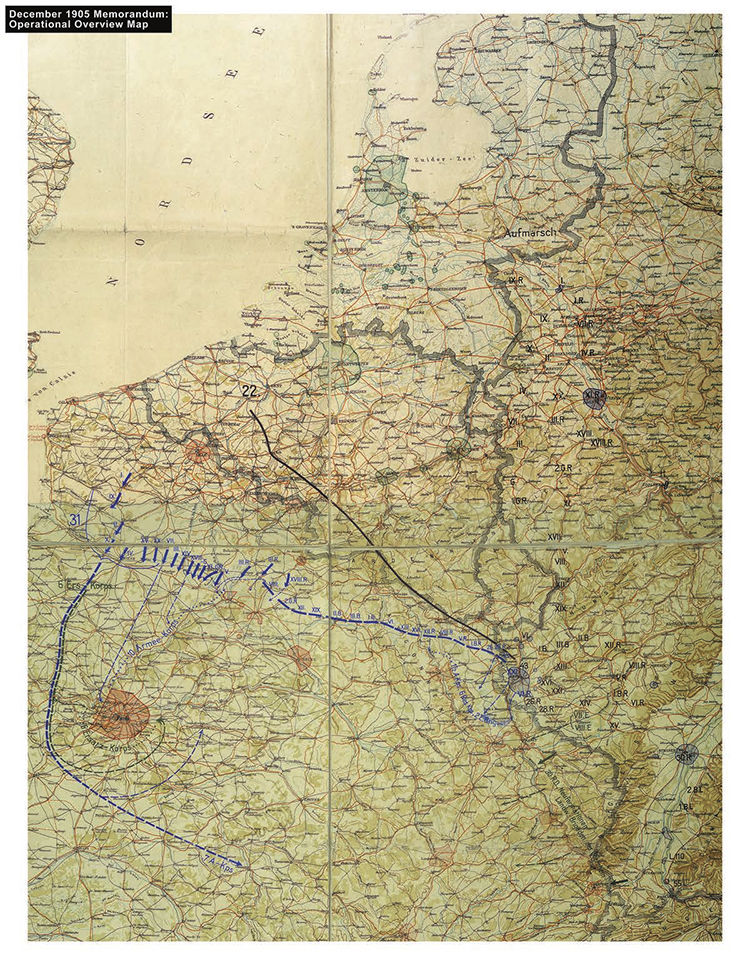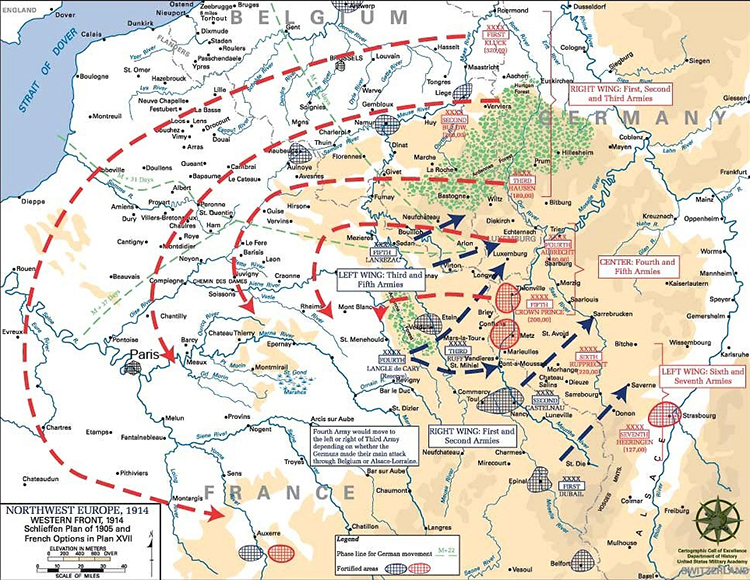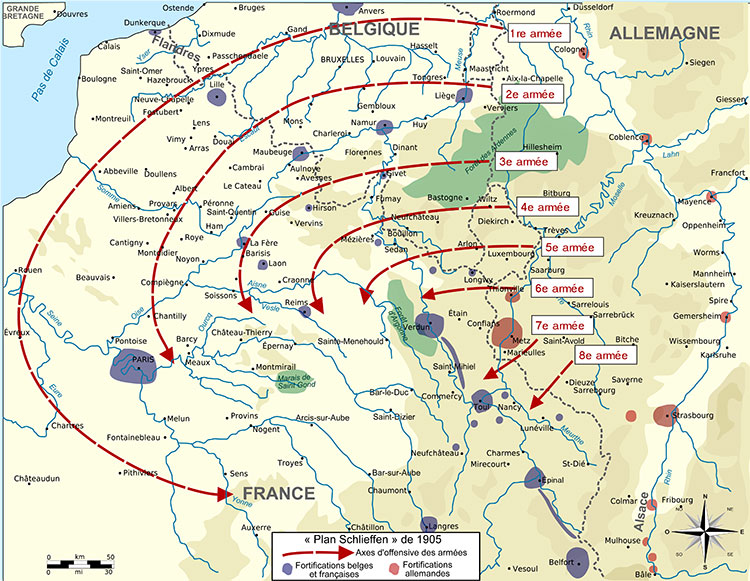Slave to the Game
Online Gaming Community
ALL WORLD WARS
SCHLIEFFEN, SUPERSTAR OF MILITARY PLANNING
by Peter Kauffner

Alfred von Schlieffen was chief the German General Staff from 1891 to 1906.
Alfred von Schlieffen (1833 –1913), colorized by Musvage.
It is the fate of military plans to be forgotten once the operation is over. Yet the Schlieffen Plan, a German plan used in World War I, lives on in historical writing, a superstar of planning. In December 1905, Alfred von Schlieffen, chief of the General Staff from 1891 to 1905 wrote his “Great Memorandum” which proposed that the German army invade France through Belgium. This plan was far more ambitious than Schlieffen’s previous plans. It certainly required more soldiers, including what historians refer to as “ghost divisions,” entire divisions that Germany didn’t actually have. Kaiser Wilhelm II was no doubt pleased. He had a boyish enthusiasm for proposals that involved invasion or conquest. After all, making it work wasn’t Schlieffen’s problem. He was on his way out as chief of the General Staff. All he had to do was turn a deployment plan over his successor, Helmuth von Moltke, who seems to have done very little with it for the next four years.
Why is this plan so well remembered today? A major factor was Schlieffen’s curious attitude toward operational security. He wrote an article describing his plan entitled “War of Today,” which was published in the 1909. (Schlieffen, 194-205) This version of the plan was even more ambitious than the one handed to Moltke in 1906. “When you march into France,” he wrote, “let the last man on the right brush the Channel with his sleeve.” That is to say, the plan imagined a block of German soldiers advancing that would stretch from the English Channel to the Swiss border.
Although Schlieffen is often portrayed as a master technician, political pressures from Kaiser Wilhelm II clearly played a role. Schlieffen’s General Staff maintained an alternative plan to play defense in the west while mounting an offensive against Russia. This plan featured fewer high-risk elements, which raises the question as to which of the two plans was intended for real-world use.
In the campaign, the Germans advanced across northeastern France. When they ran out of supplies, they dug in along the Marne river. Four years of trench warfare followed. The war, now called World War I, ended in German defeat. The officers had all read “War of Today,” so they had opinions as to why Moltke had fallen short. “Schlieffen’s notes have come to an end, and so have the wits of Moltke,” wrote future Commander in Chief Erich von Falkenhayn. (Gross, 8) Karl Ritter von Wenninger, the Bavarian military representative, wrote in his diary, “Moltke and his subordinates were completely sterile. They could only turn the handle and run Schlieffen’s film and were clueless and beside themselves when the ball got stuck.” (Mombauer, 59)
Historiography
Schlieffen’s plan was highly praised in the 1920s and 1930s by a group of semi-official writers who worked with the Reich Archive. These writers were called the Schlieffen School. As a result, the plan had a towering reputation for many years.
Schlieffen’s original memorandum outlining the plan was published in the 1950s by Gerhard Ritter. Ritter’s book details various flaws in the plan. Germany never had enough soldiers to carry the plan out, among other issues.
A flood of scholarship appeared in 2014 for the hundred-year anniversary of World War I. The General Staff’s depIoyment plans were translated and published. (Gross, 339-526)
Development
As early as 1899, Schlieffen begin shifting from a counteroffensive strategy to one based on flanking and envelopment. (Foley, Origin) Schlieffen laid out his plan in a “Great Memorandum” dated December 1905. (Schlieffen, 163) In some ways, it was a continuation of earlier plans. “Schlieffen’s ideas about this offensive developed from relatively shallow outflanking maneuver toward the final grand envelopment of the 1905 memorandum,” according to Foley. (Foley, War, 70)
The 1905 plan assumes more resources than previous plans, resources that Germany did not have. The plan can be thought of as an ideal for the future. The memo was used to create a deployment plan that Schlieffen passed along to his successor Helmut von Moltke. It was, “A program for further expansion of the army and its mobilization,” as the Reich Archive described it in its 1925 catalogue. (Gross, 103)

This version of Schlieffen’s plan to invade France through Belgium that was found in the German archive. It was used in the “Great Memoradum” of 1905.
Starting in 1900, German military academies began to emphasize offensives, flanking, envelopment, and avoiding frontal attacks, according to the French attaché in Berlin. The following year, German maneuvers began to stress envelopment. The Belgian high command warned the French that these changes suggested that a plan to invade France through Belgium was being developed. Although work on the German rail system suggested that it was being upgraded for military use, French intelligence predicted that it would be years before the Germans had enough rail capacity to carry out a advance on a broad-front. (Tanenbaum, 151-152)
What two-front war?
The reference works agree that the Schlieffen Plan was a response the threat of a two-front war. (Gross, 1, 68) But it seems that this was not Schlieffen’s view. “In a war against Germany, France will probably at first restrict herself to defense, particularly as long as she cannot count on effective Russian support,” according to the Memorandum. This would certainly have been true in 1905 when Russia had its hands full with Japan and revolution.
If Schlieffen wasn’t worried about foreign invasion, what problem was addressing? Foley presents an alternative theory concerning the plan’s origin. Schlieffen’s favored strategy was the counteroffensive, that is, to strike when the enemy was extended. The switch to an offensive may have been motivated by the fear that the French would not mount an offensive of their own, according to Foley. This could result in repeated German frontal attacks on French positions, an outcome Schlieffen feared. (Foley, Origin)

This is the classic view of the Schlieffen Plan. “Let the last man on the right brush the Channel with his sleeve,” Schlieffen once said. This version features a broad front that disregards practical limitations. The map was created in 1938 by the United States Military Academy for a course entitled ”History of the Military Art.”
Cult of the offensive
The Schlieffen Plan is based on a a style of military thinking called the cult of the offensive (L’offensive à outrance). According to this doctrine, if you can take the offensive, you should. (Van Evera)
This doctrine can be traced to the book On War (1832) by Prussian strategist Carl von Clausewitz. Its influence grew in the 1890s when it was promoted by Ferdinard Foch, then a teacher at the French military school, L'École de Guerre. When Joseph Joffre became commander in chief in 1911, it was adopted as policy.
The Avenger
Wilhelm was attempting to improve relations with Russia in 1904-1905, so he may have asked Schlieffen not to distribute plans for an attack on Russia to avoid damaging relations. (Gross, 112). The intelligence war may also explain Schlieffen’s tendency to exaggerate the resources at his command, including the use of ghost divisions. (Gross, 107)
The kaiser’s concern that plans could leak was well-founded. In late 1903, an agent called The Avenger sold a copy of the deployment plan to French intelligence. During negotiations, The Avenger kept his face covered with a bandage, but allowed his preposterous Prussian mustache to stick out in a manner worthy of a spy thriller. It was an extraordinary breakdown of security at the General Staff, an organization that otherwise never leaked. Did an officer betray Germany, or did Schlieffen plant documents to assist the kaiser’s diplomatic efforts? (Tanenbaum, 153-154)
Crises in Russia and Morocco
When Russia moved its troops east to fight Japan in January 1904, Wilhelm was overjoyed. He was eager to redeploy the soldiers who had been protecting the east from Russian invasion to the west to invade France. (Röhl, 309)
At a conference on the night December 20-21, War Minister Ernst von Einem told the kaiser that the German army was not yet ready for war. German artillery was inferior to French artillery. An upgrade to recoiless artillery was expected to take a year. The infantry was being equipped with new rifles and new ammunition. A high seas fleet had yet to be built. The biggest problem of all was that the German public did not support a war for Morocco and that the socialists could revolt, as had just happened in Russia. (Röhl, 327)
The Agadir incident in 1911 convinced the Germans that the Anglo-French alliance was solid. Germany could not outbuild a combine Anglo-French fleet, so the naval strategy was abandoned. Resources were shifted to the army.
The German public was far more belligerent in 1911 than it had been in 1905. The Reichstag
approved expansions of the army in December 1911, October 1912, and, most notably, in July 1913. Germany was spending itself broke, but Schlieffen’s plan was at last ready to go.

Deployments in August 1914. This is the Schlieffen Plan as modified by Moltke, German commander at the start of World War I. Notice that Moltke, unlike Schlieffen, did not deploy an army west of Paris. Source: https://commons.wikimedia.org/wiki/File:Plan_Moltke-Schlieffen_1914.svg
Why did the Schlieffen Plan fail?
The view that the plan represented a military masterpiece was promoted in the 1920s by a group of writers called the Schlieffen School. The group, worked with the Reich Archive to rehabilitate the image of the German military.
In the 1950s, German historian Gerhard Ritter answered the question that now plagues British schoolchildren when they take their O-level exam: “Why did the Schlieffen Plan fail?” (Ritter) Schlieffen proposed an all-out offensive against an army whose firepower was roughly equal to his. A successful offensive requires that the attacker have a significant advantage in terms of firepower or something else. The only advantage that Germany had was that the French military’s single-minded focus on Lorraine. As this sector was well fortified, the attack here did not greatly concern the Germans. The French had interior lines of communication and a rail system to redeploy for counterattacks. The Germans, meanwhile, marched on foot as the French had destroyed the rail system when they retreated.
The plan contemplated a vast flanking action that would wheel around Paris from the west. This required far more soldiers than Germany had, either in Schlieffen’s time or in 1914. In the end, Moltke deployed all his troops to advance east of Paris and hoped for the best. The Schlieffen School faulted him for modifying the plan in this way, but its hard to see what else he could have done. More troops would not have helped. Supply issues pushed the rail system to the limit as it was.
In addition, the plan expected German soldiers to do a superhuman amount of marching. Meanwhile, the French army was expected to retreat without counterattacking or otherwise disrupting the plan. In an era when Ford was producing Model A’s on an assembly line, the problem suggested a need for motorized infantry. But it seems that the General Staff did not have the imagination to think in these terms. (O’Neil, 118)
“The basis for Schlieffen’s formula for quick victory amount to little more than a gambler’s belief in the virtuocity of sheer audacity,” as military historian B.H. Little Hart wrote in the preface to Ritter’s book.
To the extent that the Schlieffen plan was successful, it was because the French failed to take advantage of their interior lines to launch counterattacks. Instead, French commander Joseph Joffre focused on an offensive to recover the “lost province” of Lorraine. This was in service of a long-standing dream of the nationalists called revanche.
Alternatives
Did Germany have any better options? On August 1, 1914, the day mobilization was ordered, the kaiser received a message stating that Britain would remain neutral if Germany did not attack France. Overjoyed, he told Moltke: “Now we can go to war against Russia only. We simply march the whole of our army to the east!” Moltke responded that this idea was impractical. There was only one mobilization plan and it was to send the German army west. Railway timetables could not be improvised, he said.
But Moltke was not telling the kaiser the whole truth. In fact, the General Staff had long maintained a fully developed plan to deploy eastward. Moreover, General Herman von Staab, head of the rail department, conducted annual exercises to make sure that his staff had experience improvising schedules. He was so outraged when he learned of Moltke’s remarks after the war that he published a book to show how the proposed changes could have been made. (Tuchman, 93) The kaiser saw Napoleon as a role model. He wanted to conquer Europe while avoiding what he saw as Napoleon’s mistake, namely war with Britain. (Röhl, 382)
After the war, historian Hans Delbrück argued that Germany should have had a defensive posture in the West and an offensive one in the East. This strategy is suggested by the extensive system of German fortification system in Lorraine and Alsace, which had been built up over many years. The multiple rings of forts around Metz were designed as a death trap for the French. But the German offensive through Belgium made this investment so much wasted effort.
This version of the Schlieffen Plan was created in 1938 by the United States Military Academy for a course entitled ”History of the Military Art.” If you compare this version to Schlieffen own, there are some inaccuracies, especially regarding the envelopment of Paris. Source: www.dean.usma.edu.
The plans
The Army Archive in Potsdam was destroyed by a British air raid in April 1945. It was long thought that Schlieffen’s deployment plans were destroyed at this time. Ritter recovered Schlieffen’s papers, including his personal copy of the Great Memorandum, from the U.S. National Archive in Washington in the 1950s. In 1996-2000, the records of the East German army archive in Potsdam were transferred to the German Military Archive in Freiburg. In 2002, they were made available to historians at the War History Research Center of the Army as record group RH61. This sparked a period of renewed debate among historians regarding pre-war military planning. A full set of deployment plans for 1893 to 1914 was eventually pieced together and published in 2014. (Gross, 88, 89, 339-526)
A infantry corps normally consisted of two divisions.
1903-1905
This is the version of the plan that was current at the time of The Avenger incident.
• Aufmarsch I: “State of War with France”
“Crossing the Belgium border is authorized only after explicit order issued by OHL…The entire force with the exception of the Seventh Army will pivot to the left through Belgium. The left wing (Eighth Army) will push to Metz and cover the left flank of the force against Verdun from a reinforced position, if necessary.”
• Against France: 25 army corps, 7 cavalry divisions, 11 reserve divisions
• Against Russia: 3 army corps, 4 cavalry divisions, 4 reserve divisions.
• Aufmarsch II: “State of War with Russia and France”
“...The preparations for Aufmarsch II are written down only in the form of a study, since this Aufmarsch was considered the less probable case.” As for operations on the eastern front, they “are not probably initially.” (Gross, 401-415)
1904-1905
This was the last set of plans whose production was supervised by Schlieffen. Unlike the previous year, there were two fully developed mobilization plans for 1904-1905. Notice that the number of reserve divisions has increased from 15 to 19.
• Aufmarsch I “State of War with France only,” This is Schlieffen’s original plan to open the war with an all-out offensive against France in the west. Unlike the plan for 1903-1904, it calls for German forces to cross the Meuse River on the way to Brussels, the Belgian capital. It ignores Russia.
“Do not enter Dutch or Belgian territory until OHL gives order to do so…In the event of an advance into Holland and Belgium, the next task of the cavalry divisions…will be to seize the Meuse bridge in Venlo, Roermond, Maaseyck and the railroads, including rolling stock. Direction of the advance will be Brussels,” according to the plan.
Against France: 26 army corps, 9 cavalry divisions, 15 reserve divisions were deployed.
Against Russia: 2 cavalry divisions, and 4 reserve divisions were deployed.
• Aufmarsch II “State of War with Russia and France”
Against France: 23 army corps, 9 cavalry divisions, 15 reserve divisions are deployed.
Against Russia: 3 army corps, 2 cavalry division, 4 reserve division were deployed. (Gross, 409-415)
1914-1915
This mobilization plan was used in World War I. It has only one option. “Germany’s preparations for war are first and foremost directed against France,” according to the preliminary remarks. “Russia will probably join France in a war against Germany. The English are expected to the hostile.”
“By 1800 hours on the 2nd mobilization day the Belgian government must decide whether Belgium will be Germany’s friend of enemy,” according to the plan. That will require the Belgains to open immediately the fortifications of L. Huy and Namur to the German army; to make the railroads…available to us; and not to mobilize the Belgian army.”
German strength is given as 26 army corps, 13 reserve corps, 11 cavalry divisions, and 1 Landwehr corps.
Against France: Germany would deploy 23 army corps, 11 reserve divisions, 171⁄2 combined Landwehr brigades, and 10 cavalry divisions. three brigades.
Against Russia: 3 corps, 1 reserve corps, 1 cavalry division, and a Landwehr corps of three brigades. (Gross, 517-525)
Bibliography
• Foley, Robert T., “The Origins of the Schlieffen Plan,” War in History, April 1, 2003.
• Foley, Robert T., “The Schlieffen Plan: A War Plan,” Hans Ehlert, Michael Epkenhans, Gerhard P. Gross (editors), The Schlieffen Plan: International Perspectives on the German Strategy for World War I, 2014.
•Gross, Gerhard, and Hans Ehlert, Michael Epkenhans (editors), The Schlieffen Plan: International Perspectives on the German Strategy for World War I, University of Kentucky Press, 2014.
• Gross, Gerhard, “There was a Schlieffen Plan,” Hans Ehlert, Michael Epkenhans, Gerhard P. Gross (editors)
The Schlieffen Plan: International Perspectives on the German Strategy for World War I, University of Kentucky Press, 2014.
• O’Neil, William D., The Plan The Broke the World: The “Schlieffen Plan” and World War I, 2014
• Ritter, Gerhard, The Schlieffen Plan: Critique of a Myth, 1958.
• Röhl, John C.G., Willhelm II: Into the Abyss of War and Exile, 1900-1941, 2014.
• Schlieffen, Alfred von, Foley, Robert (editor), Alfred von Schlieffen’s Military Writings, 2002.
• Tanenbaum, Jan Karl, “French Estimates of Germany’s Operational War Plans.” Knowing One’s Enemies: Intelligence Assessments before the Two World Wars, 1984.
• Tuchman, Barbara, Guns of August, 1962, 2009.
• Van Evera, Stephan, “The Cult of the Offensive and the Origins of the First World War,” International Security, Summer 1984.
About the Author
Peter Kauffner lives in Sequim, Washington. He is a writer and a teacher. His public email address: kauffner@yahoo.com